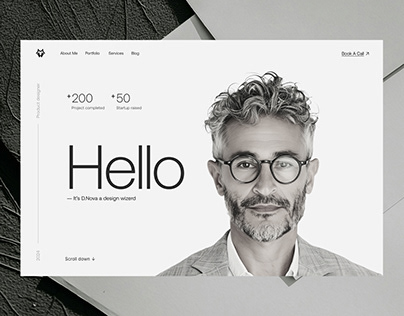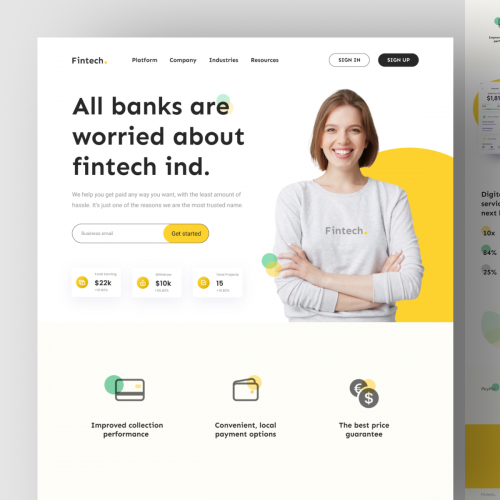Modern Site Layout That Records Focus and Converts
In a significantly electronic landscape, modern internet site layout has emerged as an essential variable in recording user interest and driving conversions. By purposefully utilizing visual hierarchy, receptive layouts, and involving interactive components, designers can create experiences that not only bring in visitors yet likewise facilitate significant interactions. Furthermore, effective call-to-action approaches play a vital function in guiding customers towards wanted results. As we check out these essential parts, it comes to be clear that understanding their interaction can substantially affect an internet site's efficiency and individual contentment. What are the essential aspects that absolutely make a difference?
Significance of Visual Hierarchy
Visual pecking order is an essential element in internet site style, as it guides customers' attention and improves their total experience. By tactically organizing content, developers can direct customers to the most crucial information first, consequently increasing interaction and enhancing functionality.
Incorporating a sensible flow in web content setup is vital; as an example, positioning the most important info on top of a page cultivates instant acknowledgment. Regular use of typography, such as varying font dimensions and designs, aids establish a clear material framework. This company not just help in navigation yet likewise develops trust, as customers feel more comfortable when they can quickly locate what they are searching for.
Inevitably, a well-executed visual pecking order not only boosts aesthetic charm however additionally considerably impacts individual habits. By prioritizing essential elements and making sure a smooth experience, developers can effectively transform visitors into customers, reinforcing the relevance of this fundamental design principle in modern site advancement.
Responsive Layout for All Instruments
Developing a smooth experience throughout numerous tools is important in today's digital landscape, where users gain access to sites from mobile phones, tablets, and desktops alike. Receptive layout is a vital strategy that ensures web sites adapt fluidly to various display resolutions, sizes, and orientations. By utilizing adaptable grids, pictures, and CSS media queries, developers can develop layouts that maintain aesthetic honesty and functionality, no matter the tool being utilized.
The value of responsive style prolongs past aesthetic appeals; it directly influences customer involvement and conversion rates. An internet site that works well on all devices urges longer visits and lowers bounce rates, as customers are much more most likely to connect with content that is very easy to navigate. Additionally, search engines, especially Google, prioritize mobile-friendly websites in their positions, making responsive style a vital part of search engine optimization (SEARCH ENGINE OPTIMIZATION)
Integrating responsive style not just enhances individual experience but additionally improves the advancement procedure. By developing a single site that functions across gadgets, businesses can conserve time and sources contrasted to developing different mobile and desktop versions. Ultimately, receptive layout is an essential method for modern-day website design, ensuring availability and complete satisfaction for all individuals, no matter their device.
Involving Interactive Components
While a responsive design lays the foundation for a practical website, incorporating engaging interactive components is essential for capturing user attention and fostering deeper connections. Website Design. Interactive aspects, such as animations, quizzes, and clickable infographics, develop an extra dynamic individual experience, motivating visitors to spend even more time on the site
Incorporating interactive attributes can also direct customers via facility info, making it simpler to digest content. Interactive sliders can illustrate item variations, while embedded video clips can offer presentations or reviews that resonate even more than fixed images or text. Gamification techniques, like incentives for finishing tasks or involving with content, can enhance customer inspiration and retention.
Reliable usage of interactive aspects not only improves the user experience but can also bring about higher conversion prices. By making communications helpful and delightful, businesses can grow a sense of commitment and trust with their target market. It is important to stabilize interactivity with efficiency; excessively complicated attributes may prevent website rate, adversely influencing user contentment. Eventually, incorporating properly designed interactive components can substantially boost a website's effectiveness, driving interaction and conversions in today's affordable digital landscape.
Streamlined Navigating Practices
Efficient navigation is a keystone of any type of successful site, as it straight affects user experience and material access. Structured navigating practices guarantee that customers can quickly locate details, enhancing their communication with the website. A well-structured navigating food selection should be simple and intuitive, usually featuring a limited variety of key classifications to prevent overwhelming visitors.
To attain streamlined navigating, developers must focus on an ordered framework that logically arranges material. Applying breadcrumb routes can provide customers with context regarding their current place within the website, permitting seamless backtracking. Additionally, utilizing drop-down menus can efficiently save space while still providing accessibility to subcategories.
Receptive style is vital, as navigation should be functional across all tools (Website Design). Mobile individuals, specifically, gain from touch-friendly menus and collapsible sections that preserve usability without jeopardizing visual appeals

Reliable Call-to-Action Methods
A well-crafted call-to-action (CTA) is crucial for leading individuals towards desired end results on a web site, as it motivates them to involve with material or make an acquisition. To maximize their performance, CTAs need to be clear, compelling, and strategically positioned throughout the site.
First, utilize action-oriented language that interacts urgency or value, such as "Start," "Join Currently," or "Claim Your Price cut." This special info language not only inspires customers yet also sets clear assumptions concerning the following steps.
Second, consider style components; CTAs must stand apart aesthetically through contrasting colors, enough whitespace, and famous positioning. A button that is easy to see and click increases the chance of user communication.
Additionally, individualizing CTAs based upon user habits or demographics can significantly improve engagement. Customized messages reverberate more with individuals, driving greater conversion prices.

Conclusion
In final thought, modern-day website layout highlights the integration of visual power structure, responsive designs, engaging interactive components, streamlined navigating, and effective call-to-action methods. These parts jointly improve individual experience, guaranteeing that site visitors remain involved and inspired to discover web content further. By prioritizing these style concepts, services can browse around this site substantially boost customer retention and conversion prices, ultimately resulting in higher success in the electronic landscape. The continuous development of internet layout emphasizes its vital duty in effective on the internet interaction and marketing.
In an increasingly electronic landscape, modern-day internet site design has actually emerged as an essential element in capturing customer focus and driving conversions.Aesthetic pecking order is a vital element in internet site style, as it overviews individuals' interest and boosts their general experience.The significance of responsive design extends past aesthetics; it straight affects user involvement and conversion prices.Incorporating receptive layout not just enhances customer experience however additionally enhances the advancement procedure. Eventually, receptive style is Homepage a fundamental technique for contemporary internet site style, ensuring access and fulfillment for all individuals, regardless of their tool.